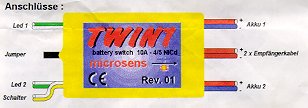Microsens : Dual Power Supply
 Twin 1:
Twin 1:
Dual power supply microprocessor operated controller for radio receiver power packs,
suitable for 4,8 volts (4 cells) and 6.0 volts ( 5 cells),
including two ultrabright LED's to indicate power level.
DUAL POWER SUPPLY " TWIN "
By Fred Harno
Last year I wrote about the little, but powerful device made by microsens in Austria to keep the glow plugs going in single and multi cylinder engines. The equipment is still performing well with my 4-cylinder OS Pegasus.
Not surprising, when I heard of something new from the same developer, I had to have it to try to solve a little problem I had encountered: Many reports have been written about loss of a flying model because of battery failure, switch failure, general power supply problems and damaged wiring from battery to receiver. Dual power supply using a diode based device do work, but the exposure due to switches breaking or the single supply cable being damaged remained. Also, one must use 5 cell (6 volt) batteries. For most models, the extra weight (and cost) stopped us considering such an installation.
At this point my two newly acquired TWIN 1 dual power supply and switch units usable with 6.0 and 4.8 volts seemed to be the answer to my prayers!
Well, more than one year testing followed: one unit in my humble "High Boy" and other much larger models, and the second one in the ľ scale 10 ft "Citabria". I can safely attest to the quality, usefulness and performance of the TWIN 1. During the test, 4 or 5 cell batteries where successfully used. Only one small inconvenience was noted: the wire to one LCD disconnected due to excessive install/uninstall in to the various planes, but it was quickly mended!
This modern piece of electronics, app 15 x 25 x 4 mm, weighing only 25 grams is easily installed with the help of double-sided servo tape. Depending on the number of cells (4 or 5) used the jumper is left or removed. After connecting the two batteries - a plug connection should be used and installed so that easy separation and access is given for connection of charging leads.
Two (!) separate supply cables are to be connected to the receiver. One in the usual "B" socket, the other to any free socket or via a Y-lead parallel to a servo. This achieves "dual redundancy" and reducing possibility of loss of power because of a damaged wire.
With part of its circuitry TWIN 1 is switched on or off electronically. The switch supplied and already soldered to the unit activates this. The switch does not interfere with the power cable in and out of TWIN1 direct.
For safety the activation takes place when the circuit through the switch is opened! This assures power supply even if the switch is disconnected or the switch cable is damaged.
Two bright LEDís indicate the power level in each battery. In normal situations they will flash alternatively, indicating that power is available from both power packs. As faster the rhythm, as more power is available. The flashing lights indicate that power is drawn from both packs in alteration, always switching to the one with the higher energy level.
If one of the LEDís stops, flying must stop, but there is an sufficient safety level available for an safe landing, as long one does not take off with only one LED operating.
I measured the remaining capacity in both batteries after a flying afternoon and found, that both had used up exactly the same capacity, every time I did this test time.
For safety reasons, I would always recommend dual power supply. TWIN1 makes it possible to use it in small models, with 2 x 500 mAh or 2x800 mAh packs and not 1 x 1200 mAh without weight penalty, but with a proven risk reduction!
Only recently, a 7m (21 ft) Glider was saved by TWIN1 after one battery failed during flight!
Technical data:
rating : 10 A
Size : 40x25x11 mm
Weight app 25 grams
Usable radio equipment - all systems, including PCM
Power consumption : 15 mA on 50 ĶA off
Just to add a bit of news: microsens intend to market in spring TWIN2, a microprocessor controlled dual power supply unit. Added features are indication of actual voltage with green/red LEDís. 1 or 2 channel being monitored and counting impulse interference during the flight, to be indicated through the LEDís after the flight when requested!
The unit can be obtained trough airvideofred or
W. Owens, 41 Main Street, Bray Co. Wicklow
Back
 Twin 1:
Twin 1: Twin 1:
Twin 1: